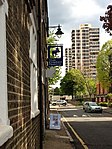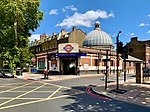St Paul's Church, Newington
20th-century Church of England church buildingsChurch of England church buildings in the London Borough of SouthwarkGrade II listed buildings in the London Borough of Southwark

St Paul's Church is a parish church in Lorrimore Square in the London Borough of Southwark. The church describes itself as St Paul's, Lorrimore Square.
Excerpt from the Wikipedia article St Paul's Church, Newington (License: CC BY-SA 3.0, Authors, Images).St Paul's Church, Newington
Lorrimore Square, London Elephant and Castle (London Borough of Southwark)
Geographical coordinates (GPS) Address Nearby Places Show on map
Geographical coordinates (GPS)
| Latitude | Longitude |
|---|---|
| N 51.485055 ° | E -0.100686 ° |
Address
St. Paul's, Lorrimore Square
Lorrimore Square
SE17 3QT London, Elephant and Castle (London Borough of Southwark)
England, United Kingdom
Open on Google Maps











